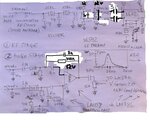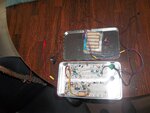truffaldino
Junior Member level 3
Hello,
I have made 100 nanowatt cw breadboard transmitter on 16mhz "computer" crystal.
The signal is picked up by dc breadboard receiver also based on comuter 16mhz crystal.
I can hear the signal at distances of about tens of meters, but when I am trying bigger distances combined with increased sensitivities, I am getting very strong noise.
I tried to find origins of the noise by putting dummy load (50-500 ohms resistors) between ground and receiver antenna entry. Dummy load does not produce strong noise. So my conclusion is that origin of this noise is either
1) noise in the 16MHz band, or
2) interference between antenna and receiver (the longer is antenna, the bigger is the noise).
Which one of two could be correct cause?
Should I connect antenna through long coaxial cable to get the answer?
Thank you in advance
Truffaldino
I have made 100 nanowatt cw breadboard transmitter on 16mhz "computer" crystal.
The signal is picked up by dc breadboard receiver also based on comuter 16mhz crystal.
I can hear the signal at distances of about tens of meters, but when I am trying bigger distances combined with increased sensitivities, I am getting very strong noise.
I tried to find origins of the noise by putting dummy load (50-500 ohms resistors) between ground and receiver antenna entry. Dummy load does not produce strong noise. So my conclusion is that origin of this noise is either
1) noise in the 16MHz band, or
2) interference between antenna and receiver (the longer is antenna, the bigger is the noise).
Which one of two could be correct cause?
Should I connect antenna through long coaxial cable to get the answer?
Thank you in advance
Truffaldino

